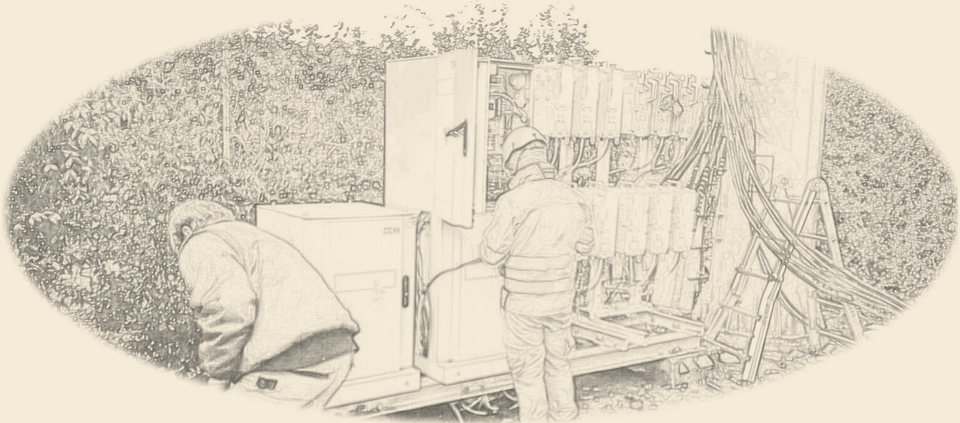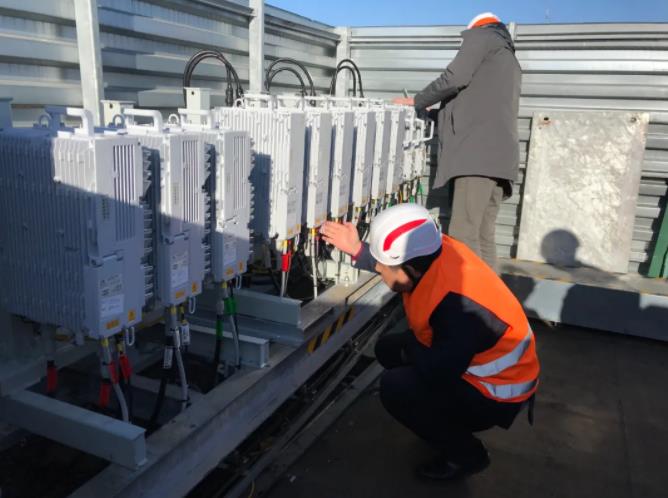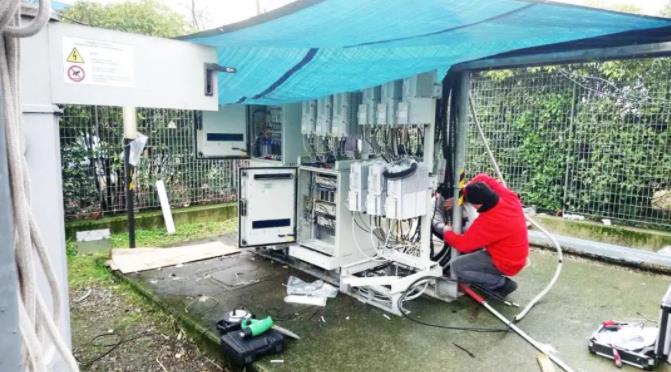Italy: Life on Cloud
By Ma Liwenbo
[Italy] Gabriele Sgariglia
In April 2020, when the novel coronavirus epidemic was raging through Italy, a music video featuring Italian and Chinese singers singing "together" became an online sensation. Twelve famous Italian singers, confined to their home due to the epidemic, sang the famous aria "Nessun Dorma" from Puccini's opera Turandot on their respective balconies. The videos of their performance were synthesized with videos of Chinese singers singing the Chinese folksong Mo Li Hua, using computer technology. The resulting composite video, titled Together, was a symbol of the solidarity between the two countries during adversity.

This exciting feat was made possible by the collaboration between Italian telecom operator Wind Tre (WT) and Chinese technology company ZTE, which provides network support for WT.
Speed Is Key for the Internet
Italians are among the heaviest users of smartphones globally. When the Italian Government put cities on lockdown to halt the spread of Covid-19, people turned more and more to their smartphones, watching online videos to pass the time.
Antonio, an undergraduate student in Milan, was separated from his family but they kept in touch through the Internet. "We make video calls at least once a day to see that everyone is safe. Thanks to the stable Internet connection, my parents can see through video link what's going on in the street under my balcony every day, and I can see every detail in my hometown," he said. "We will pull through."
High-quality Internet has played a big part in Italy's battle against the coronavirus. Through Internet connection people sent real-time videos, shopped online, ordered food, delivered goods, as well as did their work and got entertainment. Information was transmitted between digital terminals precisely and instantly, connecting countless individuals.
A few years ago, when Antonio was using the 4G service of Wind Telecomunicazioni, he found the service harrowing with low-pixel images and video and audio calls getting disrupted all the time. "I stopped making video calls," he said. "My friends called my phone a dumb old thing that could only send pictures, even though it was brand new."
Now, Antonio makes a lot of video calls, and more of his friends are calling him online. This happened after Wind's networks were upgraded.
In 2016, Wind merged with 3 Italia to form WT. Before that, three equipment manufacturers provided service to the two mobile operators and their outdated equipment and low level of integration resulted in limited coverage and capacity, unable to sustain 4G evolution. After the merger, WT launched an overhaul of its services, aiming to incorporate the previously separate networks with a substantial upgrade. It was not an easy job. An Italian client called it "Europe's hardest project in the past decade."
In the end, this hardest project was done by ZTE.
The project began in early 2017. ZTE provided a solution plan that unified equipment management, operation and maintenance, and made resource sharing between systems possible, saving WT more than 30 percent in network development costs. 4G usage growth was planned ahead, with enough capacity designed for the next five years. By integrating key technologies, ZTE gave a performance boost to WT's commercial 4G networks, increasing the download speed to 1Gbps and above.

Careful inspection before switching on the remote radio unit
The project was completed in 2020. With a 293-percent increase in network traffic, WT now has a much wider coverage, especially indoors. P3, a well-known third-party network quality testing service in Europe, ranked WT first in Italy in terms of its total score, download speed, the call-through rate of audio calls, and the dropped call rate. WT has grown into Italy's largest and best mobile service provider.
With the help of ZTE, WT has integrated its 2G/3G/4G networks, and maintained low costs for long-term evolution with a guaranteed smooth transition to 5G networks, expected to start in 10 cities by the end of 2020.
One WT partner company has begun strategic planning based on 5G technology: smart video surveillance, augmented reality telemedicine service, smart grid, mobile wallet, building structure health monitoring, augmented reality/virtual reality visit, precision agriculture and supply chain-traceable food…. With 5G technology, these will all become reality very soon.
Growing Trust in Dark Times
In April 2018, ZTE suffered a grave crisis, which put the WT program on hold for three months. But the ZTE team did not stop working. They did whatever they could – improving efficiency, maintaining ties with subcontractors, and smoothing things out the best they could.
During that period, ZTE technical director Liu Kai and his team kept working at the Italy office, not on technical research and development but trying to create more value in the shortest time possible.
In line with the compliance regulations of the company, the team could only work out solutions on paper for optimization of various gadgets to improve efficiency and network performance. When resuming normal work, the technical team impressed their client with these improvements and more importantly, their professionalism.
Most of the subcontractors in Italy are locally based and small, running on high labor costs but low on cash flow. These caused problems in cooperation and low productivity.
Seizing the window created by the crisis, the team sorted out the main problems and talked with the subcontractors face to face. The team took full consideration of their interests and promised not to delay payments even if something went wrong in the worst case. Convinced of the team's sincerity and professionalism, the subcontractors adopted a more objective attitude.

Installing equipment for the WT program
It turned out that the crisis helped the two sides increase mutual trust and collaboration. When work resumed, the subcontractors, now fully confident of their partnership with ZTE, quickly leveraged all their resources for the next stage of the program.
WT's Marco Polos
Fabio L. is head of technical operation and maintenance at the WT program. When he was young, he was impressed by the grandeur of the Forbidden City he saw in the 1987 film The Last Emperor, and had always wanted to visit China.
To enhance mutual understanding, ZTE organized an event, "Marco Polos at ZTE", consisting of three trips for 50 Italian employees to China.
As one of them, Fabio L. finally realized his childhood dream. Before he arrived in China, he had already formed an impression of China – a combination of modernity and tradition – through the books he had read. The trip proved his impression correct.
In China, Fabio L. received training at the ZTE Academy in Shenzhen. He also visited the Great Wall and the Forbidden City with his colleagues. He said, "I have experienced technology, modernization and the city of the future in Shenzhen, and encountered Chinese history face to face in Beijing. Wherever I went, the people were friendly and polite, a cultural trait embedded in their genes. For me, I believe my job's value is to integrate the present and future of Italy."
Rocco G., a project manager of the WT program, has also had a rewarding experience.
Before joining ZTE, Rocco G. spent 15 years at Wind and wanted new challenges and a job with new horizons. When he learned of an opportunity at the WT program, he applied with alacrity.
At first there were not many people on the WT team, so they still worked from the Wind office. So Rocco G. still worked in his old office but representing ZTE. The fast growth of the WT project team helped him grow professionally, too. When he first joined, he was a network optimization engineer. Two months later he was promoted to project planning for good performance. His new job requires him to follow up the planning and implementation of all projects. Acutely aware of the importance of the new post, Rocco G. knows it is a rare opportunity for his career development.
He said, "While working for a telecom operator is rather uneventful, it is a different story with project teams. Internet integration projects of such size are a rarity globally, and the whole team has their eyes on 5G. I have plenty of ideas on this and get the opportunities to speak my mind here."

ZTE's Chinese and Italian employees celebrate the Dragon Boat Festival together.
The WT program has created more than 5,000 direct and indirect jobs in Italy. It has also produced a large number of telecom professionals and promoted ZTE's management and technology in the country.
Eight hundred years ago, Italian explorer Marco Polo traveled to China and wrote an account of what he saw in this mysterious empire in the East. In his account, he mentioned China's imperial post system, a network for passing messages in the country. Centuries later, the WT program has come up with a next-generation communication network for the future, facilitating a new journey for Italians in the age of the cloud.
FOR MORE
Project Overview
ZTE's Wind Tre program has built Europe's largest wireless national network. It has provided Wind Tre, Italy's largest mobile operator, a dual-network integration plan with an investment of EUR1 billion (USD1.2 billion). It is by far the largest program of its kind and with the tightest schedule; the solutions are extremely complicated, with a pioneering interface.
The program began in early 2017. A year later it finished relocating facilities in key cities and the integration of dual networks. In June 2020 network development was completed and passed appraisal. Adopting an innovative Uni-RAN solution and high-integration equipment, the program has realized the integration of 2G/3G/4G networks for Wind Tre. As a result, Wind Tre's networks have significantly improved performance: a 293.1 percent increase in data traffic, 27.1 percent increase in LTE downlink rate, 2.6 percent increase in network availability, and 52.2 percent decrease in dropped call rate. Wind Tre has since grown into Italy's largest and best network service provider. The program will continue to expand network capacity in some regions as per client needs.


